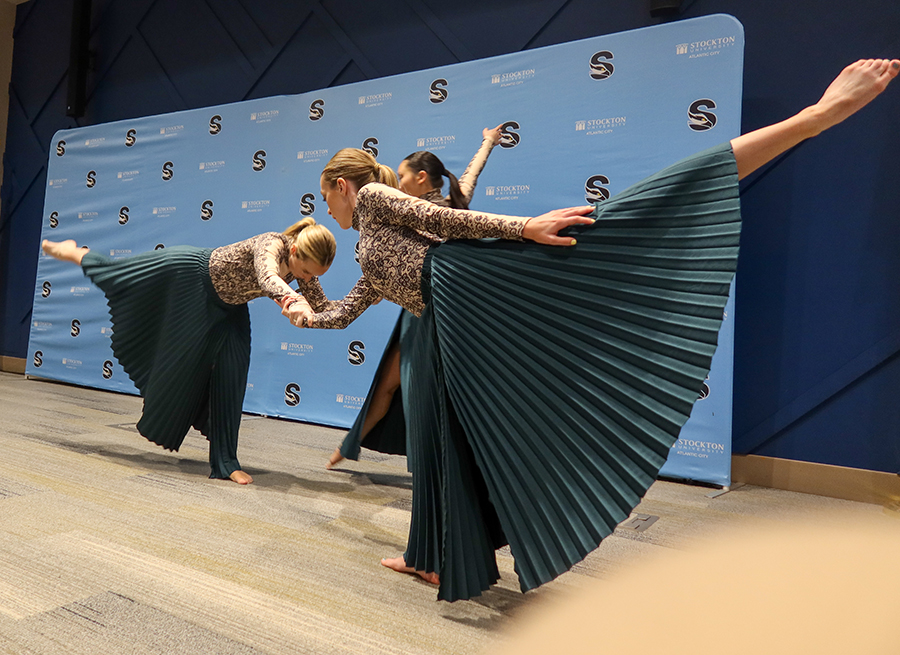Regional Summit an Anchor for Local, State Arts Organizations – News
Atlantic City, N.J. — As an Anchor Institution in the resort, Stockton University has had a positive
impact on the community and the local economy.
But President Joe Bertolino believes the university’s impact should go beyond that,
including serving as a catalyst for artistic and cultural expression in southern New
Jersey. That’s why he introduced a Regional Arts and Cultural Summit on April 8, just
four days before his inauguration as Stockton’s sixth president on April 12.
“As an Anchor Institution in Atlantic City, Stockton University is dedicated to community
engagement and recognizes the opportunities that supporting the arts brings,” he said
before a group of about 150 local and state arts representatives at the John. F. Scarpa
Academic Center in Atlantic City. “We know the arts and cultural expression have the
potential to bridge real and imagined divides in our neighborhoods and around the
world.”
At left, John Schreiber, the president and CEO of the New Jersey Performing Arts Center,
was the keynote speaker at the Arts and Cultural Summit, which was created this year
by Stockton President Joe Bertolino.
Bertolino said the summit was designed around the theme of his inauguration – “building
a community of opportunity.” Performances by Stockton student musicians and a group
of student dancers kicked off the event before a keynote address by John Schreiber,
the president and CEO of the New Jersey Performing Arts Center.
The attendees then took part in smaller breakout sessions to discuss issues such as
funding support, the arts and its role in healing, the arts and the impact it can
have on education and the power of the arts as a catalyst for social change and community
involvement.
“Our goal is to collect ideas and strategies that will be useful to others interested
in the arts to do what we all know, intuitively, to be true: The arts give us a hopeful
way to think about our world, perhaps too infrequently explored by too few people,”
said Ian Marshall, the dean of Stockton’s School of Arts and Humanities.
Some of the panelists included Stockton faculty, such as Mariana Smith, an associate
professor of Art, and from organizations that support the arts, such as Jeremy Grunin,
the president of the Grunin Foundation.
“By inviting local and regional artists and enthusiasts, and leaders in business,
government, nonprofits, community organizations and education to share ideas, strategies
and information, I believe we can strengthen the role of the arts, not just in our
communities and our region, but throughout our state and beyond,” Bertolino said.
“When we bring people with a common focus together, we can affect great change.”
Schreiber, who was an Emmy- and Tony Award-winning producer before joining the NJPAC
in Newark in 2011, spoke about how his organization, specifically, and the arts, as
a whole, can be a tool to advance citizenship, community, education and health in
the community.
“We like to think our ourselves as an anchor cultural institution,” he said. “We are
rooted in our city physically. We are part of the landscape. We’re not going anywhere,
and we can be a place for, and a facilitator of, connections between all kinds of
people across greater Newark and across New Jersey.”
Schreiber encouraged those who attended to be open minded about the arts and embrace
those with a “wild idea.” He mentioned how the NJPAC has gotten involved with events
outside Newark, including organizing the statewide North to Shore Festival and an
initiative later this year to start building a neighborhood around the center with
apartments, restaurants and shops.
“Consider it. Workshop it. See if it has legs,” he said. “The arts are incredibly
powerful, and we don’t quite know how powerful they are until we put them to the test
to see what they might be able to accomplish.”

Stockton dancers Kylie Kolmer, Abigail Bell and Abbey Butler perform as part of the
Regional Arts and Cultural Summit.
Bringing the arts to a larger audience through nontraditional means is part of the
mission of Mud Girls Studios. The nonprofit was founded by Dorrie Papademetriou as
a ceramic art studio that employs Atlantic City women in poverty. One of the studio’s
first commercial installations was at Stockton’s Kesselman Hall in Atlantic City.
“If we can gather here and take (the arts) out to the underserved, reach the people
who live here, and affect change here, that’s who I try and reach,” she said. “The
other great thing about this event is that you are bringing different people together
– people who might not ever engage with the homeless or people with mental illness.
Art should be for everyone, and I think that’s what this is really talking about –
arts and the community.”
Building connections was one of the main reasons Chase Jackson was excited to attend
the summit. As the executive director of the Ocean City Arts Center, she said she’s
always looking for new partners to develop programs with.
“I’m just tickled pink that this is something close, and I don’t have to go to Trenton
or Camden,” she said with a laugh. “For us at the southern shore, it’s a godsend.
We are very grateful to Stockton for doing this. With Stockton being the anchor university
in the area, it’s vitally important that it takes the lead on these kinds of events.”
The summit is also a huge networking opportunity for all those who attended from large
groups like the NJPAC to smaller, grass-roots organizations like the Ocean City Arts
Center and Mud Girls, said Michael Cagno, the executive director of the Noyes Museum
and the Noyes Arts Garage of Stockton University.
“Bringing artists, nonprofits and government sectors together in the same room only
reinforces the partnerships and collaborations that we have established,” he said.
“It also provides the potential for new ones. The summit is helping to break down
those barriers and provide accessibility to establish those contacts and relationships.”
Jackson hopes Stockton will host future regional arts and cultural summits with one
maybe in the spring and one in the fall each year.
“This is a good place to start to meet the people that I need to meet — all the arts
people in one place,” she said. “Just keep doing what you are doing and learn from
this one what to do next.”
— Story by Mark Melhorn, photos by Lizzie Nealis













